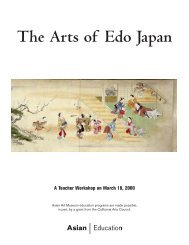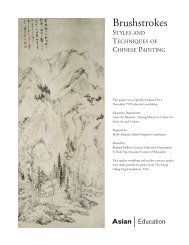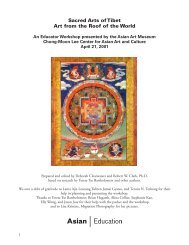Chinese Calligraphy (.pdf) - Asian Art Museum | Education
Chinese Calligraphy (.pdf) - Asian Art Museum | Education
Chinese Calligraphy (.pdf) - Asian Art Museum | Education
Create successful ePaper yourself
Turn your PDF publications into a flip-book with our unique Google optimized e-Paper software.
Tools and Materials: The Four Treasures<br />
The Four Treasures are the most essential implements for any painter or calligrapher.<br />
They are the brush, paper, the ink stick, and the ink stone,<br />
The Brush<br />
The brush is very flexible and versatile. It comes to a fine point so that it can produce<br />
very thin lines, but it is also fat enough to make wider lines and dots. To make a brush<br />
tip, one or several kinds of animal hair may be used including rabbit, wolf, goat, badger,<br />
and even the whiskers of mice. Brushes vary in size from tiny, fairly stiff wolf hair brushes<br />
for outlining to immense resilient brushes for large calligraphic scrolls. Long tapering<br />
brushes are good for swirling movements; short stumpy ones produce a blunt line with<br />
the understated impression favored by some of the scholar painters.<br />
The Paper (or silk)<br />
The next important material, paper, was invented in China during the Western Han<br />
dynasty (206 BCE–CE 9). Early calligraphers carved records in stone, cast them<br />
in bronze, or wrote them on bamboo strips or silk, but all of these materials were too<br />
expensive or too big and bulky. It was not until the Tang dynasty (618–906) that painters<br />
began to use paper on occasion, and it was not used extensively for pictures until the<br />
Yuan dynasty (1279–1368). (In fact, most early painting had been done on silk.) At first,<br />
calligraphers and painters made paper from rags. Eventually they used various kinds of<br />
vegetable fiber, including tree bark, grass, hemp, and grain husk.<br />
The Ink Stick<br />
Black ink was made from soot mixed with glue and formed into hard sticks. The finely<br />
ground soot produces the color while the glue both holds the stick together and acts as<br />
an adhesive to bind the ink to the paper or silk. Pine soot, from the inner wood of the<br />
tree, produced the best all-around ink, but other kinds of soot and various animal glues<br />
have been used. Ink compounders have experimented over the ages with different materials,<br />
sometimes adding such unlikely ingredients as powdered pearls and jade dust. Most<br />
ink makers guarded their recipes carefully, never writing them down and passing them on<br />
only to their apprentices. Therefore, the recipes for making some special ink have been<br />
lost such as that for a once-popular bluish ink.<br />
The Ink Stone<br />
To use the ink stick, painters must grind it with water on a fine-grained stone. The ink<br />
stone became one of the Four Treasures of the scholar. The quality of the stone’s grain<br />
was of the greatest importance, but stones were treasured also for their color and<br />
beauty. They were cut and carved so that they had a flat surface for grinding.<br />
<strong>Asian</strong> <strong>Art</strong> <strong>Museum</strong> <strong>Education</strong> Department 6
















